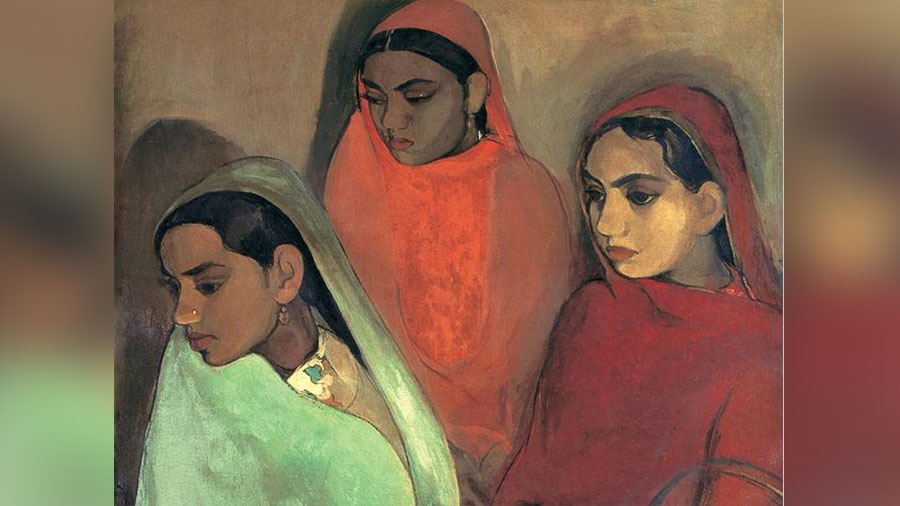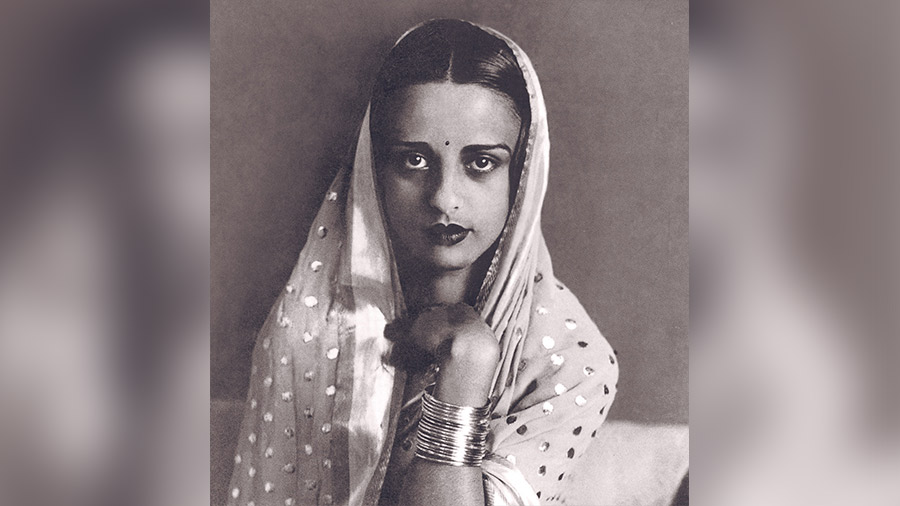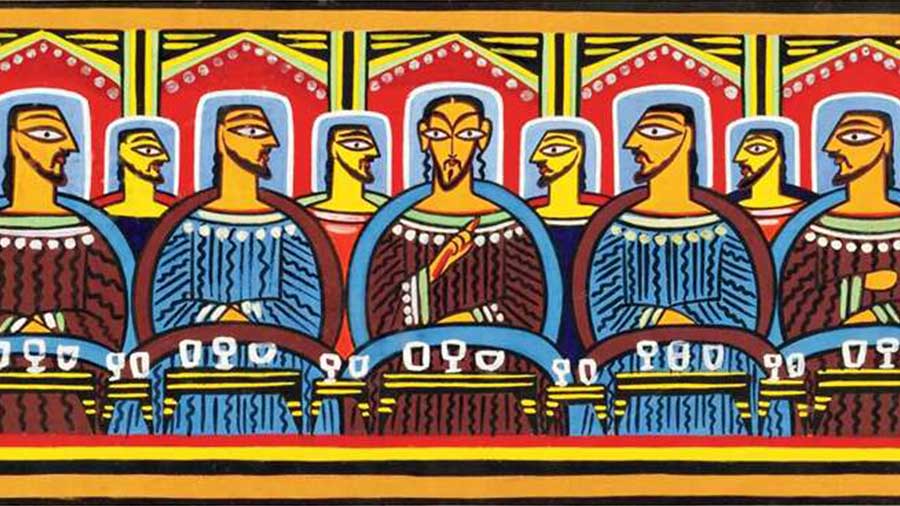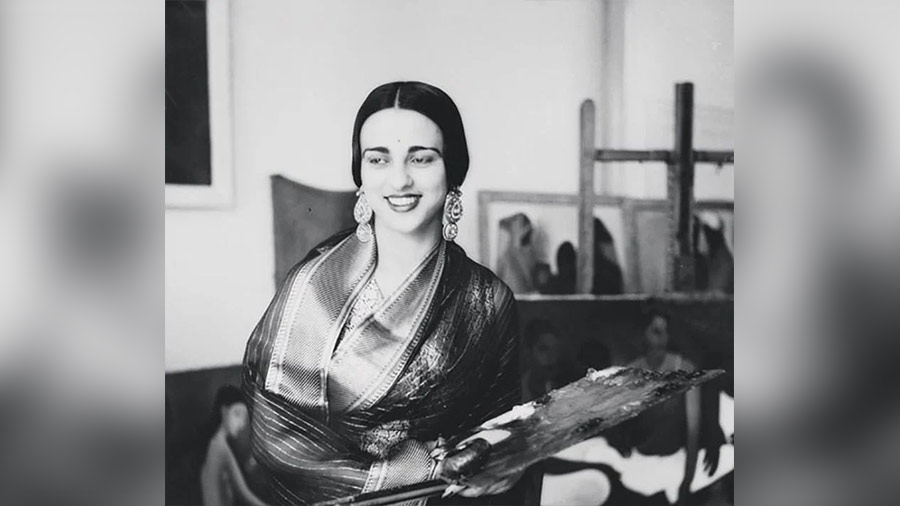“Europe belongs to Picasso, Matisse and many others, India belongs only to me,” believed Amrita-Sher Gil, one of the most talented avant-garde artists of the 20th century. Blessed with a vision to see and capture the pathos of everyday life, especially the loneliness and despair of Indian women, Sher-Gil is often hailed as India’s answer to Frida Kahlo.
Even though her works are considered to be national treasures in India, Sher-Gil’s story is riddled with “messiness that we must learn to normalise”, according to Anita Vachharajani, whose book, Amrita Sher-Gil: Rebel with a Paintbrush, won the Sahitya Akademi’s latest Bal Sahitya Puraskar for English in 2021.
A couple of days after she picked up her award in the City of Joy, My Kolkata spoke to Anita on the finer shades of Sher-Gil’s art, her life and her legacy.
Edited excerpts from the conversation follow.
When I write my next book, I’m going to pretend to myself that this recognition never happened

Anita chose a graphic book format to highlight the paintings of Sher-Gil prominently
AmazonMy Kolkata: What was your first reaction when you found out that you had won the Sahitya Akademi award for your book? How does such a recognition impact your journey as a writer and what you expect from yourself?
Anita Vachharajani: My book came out in 2018, so when, out of nowhere, on December 31 last year, I received an email saying that I had won the Bal Sahitya Puraskar in English, I was shocked. At first, I thought it was a joke, so I sent them a tentative reply asking if my publisher had been notified. As a response, I was asked to check the Sahitya Akademi website. Soon enough, the media carried reports, too. That’s when I was convinced that I had won the award for real and it was a moment of tremendous joy. I had turned 50 just a month before that, so it felt like an extended birthday present. When I told my mother about the award and the cash prize, she finally felt that my career as a writer of children’s books was a viable one!
In terms of the impact of the recognition, I’m truly grateful that my hard work for four-and-a-half years in making this book has been rewarded. My effort feels seen and validated. As writers of children’s literature, we rarely experience the limelight. There are very few bestseller lists that can demonstrate the success of our work. So, to be honoured by India’s national academy of letters is really special, more so because the ceremony happened in person, and I was able to share the stage with writers from many Indian languages. At the same time, I don’t want this award to pressure me. When I write my next book, I’m going to pretend to myself that this recognition never happened. Otherwise, with expectations higher than before, I might be setting myself up for a huge writer’s block!
Being a writer in Mumbai feels lonely… yet liberating
Talk us through what life as a writer in Mumbai looks like. Many writers in Kolkata cite the languor of the city as a cause for inspiration. What about Mumbai inspires you to write?
Being a writer in Mumbai is fairly lonely. You might have strong writing communities in Delhi and certainly in Kolkata. But in Mumbai, we don’t really get together that much. As children’s writers and illustrators, we had just started meeting more frequently in 2019, but that stopped due to the pandemic. Mumbai doesn’t let you take yourself too seriously. It doesn’t let you have many illusions either. Having said that, since nobody here is bothered even if you’re a part of something big as a writer, living in Mumbai feels liberating.
Amrita lived at a time when people were beginning to travel for leisure, exposure and the growth of the mind

‘Group of Three Girls’ is Anita’s favourite painting by Sher-Gil
PinterestComing to the book, what drew you to the story of Amrita Sher-Gil? Why did you choose to make it a graphic book?
I was studying a list related to the proposal for a book on Indian pioneers in various fields. But that list didn’t have any woman artist, which immediately struck me as something that needed change. In the West, there are plenty of delightful picture books with stories about their artists and their writers — both male and female. In India, we’re only now seeing such books on our own artists, writers and scientists. Personally, I always admired a painting of Sher-Gil’s called Group of Three Girls. So I thought, why not tell her story as a pioneering artist? I pitched it and my idea was accepted.
The format of a graphic book was chosen because it would allow for Amrita’s paintings to shine and complement the text that revealed her story. But as I kept working on the book and slipping into more rabbit holes of research, its scope kept on growing in my mind. Amrita lived at a time (the early 20th century) when people were beginning to travel for leisure, exposure and to develop their minds. So much was happening. Naturally, the book expanded and went into far greater depth than initially anticipated. In creating the book, I was lucky to find an illustrator in Kalyani Ganapathy whose vision matched mine and who allowed Amrita’s own paintings to take over after a point in the book. My editor Tina Narang was amazing — her contribution to the book went well over and above what an editor’s normally is.
In India, we need to stop protecting children from messy stories

Anita feels that it is important for children to read Sher-Gil’s story and ask questions about her art
PinterestHow important was it to make the story of Sher-Gil palatable for children in the hope of inspiring many budding artists? How challenging did you find the process?
It’s not just about inspiring future artists but also about telling children that life can be and often is messy. In India, we need to stop protecting children from messy life stories. They’re far more perceptive than we imagine. Amrita’s story is complicated, be it because of the string of lovers she had or her early death or her mother going away to Florence with the kids after falling in love with an Italian man, only to come back shortly after. But we need to normalise all narratives and stop being shocked by people’s varied life stories. It was also important to tell Amrita’s story in a way that children know that they could challenge and question her greatness. There’s no point telling the story of a great artist if you’re going to brook no debate or discussion about them.
One of the biggest challenges was to present all aspects of Amrita’s life in a way that children could understand, without being reductionist. Amrita’s style also changed a lot as an artist. It went from academic realism to a more mural-like, flatter style. It was still evolving. But how do you describe that to children without resorting to jargon? That was a challenge, as was getting permission to use her paintings as well as those of artists like Vincent van Gogh whose works had inspired Amrita.
Did any other books in children’s literature serve as a model?
There are numerous children’s picture books on artists that have influenced me — I’ve always loved James Mayhew’s Katie series, which introduce children to various Western artists and art movements.
After meeting the Nawab of Hyderabad and seeing his art collection, Amrita asked, 'Where are the Cezannes, the van Goghs and the Gauguins?'
Focusing on the subtitle of your book, what made you call Sher-Gil a “rebel with a paintbrush”? What was she rebelling against and to what extent was she successful?
Amrita was always candid and outspoken. As a child, she got into serious trouble at school. In Florence, she was caught painting nudes as a 12-year-old. In Shimla, she was asked to leave school because she refused to attend mass. She habitually annoyed fine arts societies in India, some of which would appreciate only her early work but not the more mature work of her mid-20s. Once, after seeing the art collection of the Nawab of Hyderabad, she remarked on the fact that he had only collected paintings by artists whose work she did not respect. “Where are the Cezannes, the van Goghs and the Gauguins?” she asked. The Nawab promptly returned the paintings of hers that he had planned to purchase. Amrita didn’t like sticking to tradition or being told what she could represent in her art and how.
How successful was she? That’s tricky to answer because we lost her so early (at 28). And yet, she left us with around 175 paintings across less-than-12 years of activity, which is staggering, especially when you consider how her style evolved. Most painters take decades to refine what they want to do. For Amrita, her artistic maturity came about remarkably quickly.
Amrita was painting at a time when the modern gaze had turned from looking at contemporary European art for inspiration to looking at ancient Indian art and folk art

Anita explains how Sher-Gil’s paintings were inspired by the modernist philosophy of her times
PinterestAs someone who was born in Hungary and spent extensive time travelling across Italy, France, Turkey and her home country of India, Sher-Gil was a confluence of cultures. Would it be fair to say that Sher-Gil was a painter brought up in a variety of European traditions who became a pioneer because of how she could fuse European and Indian art?
Interestingly, Amrita was also a pioneer in the sense that she was India’s first professional female artist. Before her, women who painted mostly came from privileged families and they never painted for a living. Amrita came from a position of caste and social privilege but in terms of money, she didn’t have a lot of it. While it’s true that she was combining Indian and European art, she was far from the only one to do so. Many artists were fusing different influences around that time. She was painting at a time when the modern Indian gaze was meeting ancient Indian art and folk art. Amrita herself was deeply interested in the murals and sculptures of the Ajanta and Ellora caves and of the temples of south India. She was also interested in miniature paintings. There was a churn happening with painters departing from traditional models of academic European art.
The Bengal school was her pet peeve

According to Anita, Sher-Gil was opposed to the Bengal school of painters, with the exception of Jamini Roy
TT archivesHow would you compare Sher-Gil’s work to those of artists associated with the Bengal Renaissance movement? What did she make of it?
The Bengal school was her pet peeve. Being young and brash, she declared that she was against that style of art. She didn’t like their approach, with the exception of Jamini Roy’s. And she was quite candid about it, which may have been seen as irreverence in certain sectors.
Many people felt Amrita was painting India’s poverty
Why did Sher-Gil not get anywhere near the recognition she got posthumously during her lifetime? Was it simply down to a female painter trying to break into a largely male bastion or was there something more?
I think it had less to do with her being female and more to do with her not being a compliant female. She wasn’t diplomatic and never set out to please society at large. A lot of people at the time had a problem with her depicting the sadder side of life in India — the parts that didn’t make it to the gorgeous contemporary tourism posters. They felt she was painting India’s poverty. So maybe all those things played a part in her not getting as much appreciation as she merited during her lifetime. Having said that, most artists get their due much later in life and Amrita didn’t live long enough to see her work being celebrated. Besides, it’s not as if nobody knew of or appreciated her work when she was alive. There were people writing about her and buying her art as well. Just before she passed away, she was planning an exhibition in Lahore and had given lectures and radio talks. People knew her, but perhaps not in proportion to her talent.
Amrita and Nehru were good friends… but there’s no proof of any romantic relationship

Anita believes that there is no evidence to suggest a romantic entanglement between Sher-Gil and Jawaharlal Nehru
TT archivesThough Sher-Gil came from a family that had close ties with the British Raj, her father was allied to the freedom movement. She also forged a strong relationship with the Indian National Congress during the freedom movement. Could you tell us a bit about her association with the Congress and her good friend Jawaharlal Nehru?
The intellectual inclinations of the Congress made it appealing for artists like Amrita to be associated with them. Had she lived longer, I suppose she’d have espoused a political ideology much closer to the Congress’s than the right wing’s in India. She and Nehru were good friends and they exchanged several letters. But there is no proof of a romantic relationship. Amrita had read Nehru’s autobiography (An Autobiography) and told Nehru that unlike most people who wrote well or gave good speeches, she didn’t find him pompous at all. Nehru was a big advocate of her art and after Amrita died in 1941, her family donated many of her works to the fledgling nation’s National Gallery of Modern Art (NGMA) over a decade later.
Amrita saw love and sex as separate things

Anita thinks that not enough focus is placed on Sher-Gil’s struggle and how much passion she had for her craft
Does the fact that Sher-Gil had a chaotic personal life with multiple lovers take the sheen away from her artistic legacy? Has she been remembered unfairly as an artist because of an obsession with her personal life?
When I was researching this book and looking up articles on Amrita online, I mostly found things to do with her sexuality — how she was a nymphomaniac, how many men she slept with, if she had female lovers and all that. We won’t find a similar focus on an artist’s sexuality if we Google M.F. Husain or Raja Ravi Verma. The fact that Amrita was a beautiful, independent woman who spoke her mind subjected her to a narrow gaze. In terms of her personal life, she probably saw love and sex as separate things, a view that many of us might hold today but would flinch from discussing. But her story isn’t about having multiple lovers. The lovers were incidental; her story is really about how seriously she took her craft and how hard she worked on it, while managing to have relationships, deep friendships and a lot of fun along the way. She travelled extensively across India and Europe to discover art. She was her own harshest critic. Part of the reason behind writing this book for me was to change the prism through which we view Amrita’s story and make it as much about her artistic journey as her personal one.
How much clarity can you provide on how Sher-Gil passed away, since there are conflicting theories about her death?
Based on my research, I believe she died of dysentery and not of a botched abortion as is sometimes believed.
When I talk about Amrita to kids in school, I often show them sets of two paintings by her

The portraits of Boris Taslitzky (left) and Malcolm Muggeridge, as painted by Sher-Gil
PinterestYou mentioned Group of Three Girls as your favourite painting of Sher-Gil’s. But if you had to pick a couple of others, which ones would they be?
I really like The Merry Cemetery, Hill Side and Sumair. I love how the first two are almost like miniatures in how she uses red and white in them. And Sumair is such a pleasurable painting to look at. When I talk about Amrita to kids in school, I show them many paintings by her and I always place an early painting next to a later one. One such pair has portraits of Malcolm Muggeridge and Boris Taslitzky next to each other, both of whom she was involved with at different points. Both are interesting paintings because they were made at different times in her journey. It’s fascinating how kids look at the paintings and try to assess who Amrita was happier with! They usually side with Boris on that one, with some noticing the difference in how she used colour or depicted people’s hands over time. I think being able to see the evolution in her work is more important for my young readers than any jargon I could have used to describe it.
I want to write about women scientists in India
Which are the books you are working on right now?
I want to write about women scientists in India. I want to write art-history-based fiction, which is proving to be tough! When we visited Singapore, we saw little picture books that introduced the different communities of Singapore to children over there. I want to do something similar for India. On a different note, I also want to write a romantic novel for fun.
I felt like I ate my way through Kolkata like Pacman!

Anita enjoyed the food at The Blue Poppy Thakali on her visit to Kolkata
TT archivesFinally, tell us about your time in Kolkata, where you came to collect the Bal Sahitya Puraskar. What were the highlights? And as a foodie, which places did you get to check out?
If I had to pick highlights, my visit to the Indian Museum would definitely be one. I also enjoyed the couple of amazing walks I went on with Calcutta Walks. I loved Kolkata and imagine that I’d love to visit the city in winter. As for food, I feel like I ate my way through Kolkata like Pacman! I loved the food at The Blue Poppy Thakali, 6 Ballygunge Place and Peter Cat. Indian Chinese food in Kolkata is definitely more delicious than Indian Chinese food elsewhere. We went to Bar-B-Q with my husband’s friends, and each dish tasted different from what it does in Mumbai. During one of the walks, I also got to sample the exquisite black suji ka halwa made with black jaggery. I had no idea this existed! Before leaving, notwithstanding my diabetes, I also got an obscene amount of sandesh from Mithai, which I’ve been nibbling on gradually ever since.








